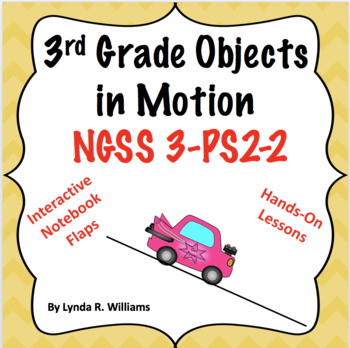3rd Grade Objects in Motion Lab and Nonfiction Passage NGSS 3-PS2-2
- Zip
Also included in
- Do you teach 3rd grade science? Students will love these engaging third-grade science lessons. Each unit meets one or more of the NGSS third-grade standards. Are you looking for resources made by someone who understands NGSS? This bundle covers all the standards for NGSS 3rd grade for the entire yeaPrice $72.36Original Price $89.55Save $17.19
Description
Students will measure an object's motion to look at patterns that can be used to predict future motion. Objects in motion can be studies through fun engaging activities. These hands-on activities and worksheets will help you teach about motion and stability.
This resource includes:
- hands-on activities
- a nonfiction article
- response pages
- interactive notebook flaps
This resource addresses the NGSS Disciplinary Core Idea of Motions and Stability: Forces and Interactions.
This resource includes lessons that address the standard:
NGSS 3-PS2-2 Make observations and/or measurements of an object’s motion to provide evidence that a pattern can be used to predict future motion.
Also addresses Utah SEEd
3.3.2 Analyze data from observations and measurements of an object’s moon to identify patterns that can be used to predict thefuture moon. Examples of objects with a predictable pattern could include a child swinging in a swing, a ball rolling back and forth in a bowl, and two children on a see-saw.
Students will love these exciting activities that are really engaging. Students will use STEM thinking and design principles in these engaging activities. Teachers will love the low prep and lessons with easy-to-find household materials.
For NGSS 3rd Grade
Next Generation Science Standards
Science and Engineering Practices Students Will Use:
1. Asking questions (for science) and defining problems (for engineering)
2. Developing and using models
3. Planning and carrying out investigations
4. Analyzing and interpreting data
5. Using mathematics and computational thinking
6. Constructing explanations (for science) and designing solutions (for engineering)
7. Engaging in argument from evidence
8. Obtaining, evaluating, and communicating information
Science Concepts:
Pendulums
Inclined Planes
First Law of Motion
Predictions
Observations
Recording Data
Gravity
Friction
Please note that the slide shows and pages are not editable. They are secure and protected by copyright. This resource is created by Teaching Science with Lynda R. Williams
Save 20% by purchasing in the NGSS third-grade bundle.
Save 20% by purchasing as part of the NGSS Huge Third Grade Bundle!
Save 20% by purchasing as part of the Utah SEEd Huge Third Grade Bundle!
If you have questions about my resources please contact me at lywilliams1@gmail.com
These resources are created by Lynda R. Williams at Teaching Science
Follow me and get news of my new resources. Each new resource is discounted by 50% for the first 24 hours!
This resource can also be purchased as part of a unit. STEM Force and Motion Unit NGSS 3-PS2-1 and 3-PS2-2
Please visit my blog
Or in a bundle at a 20% savings 3rd Grade Science Lesson Bundle



